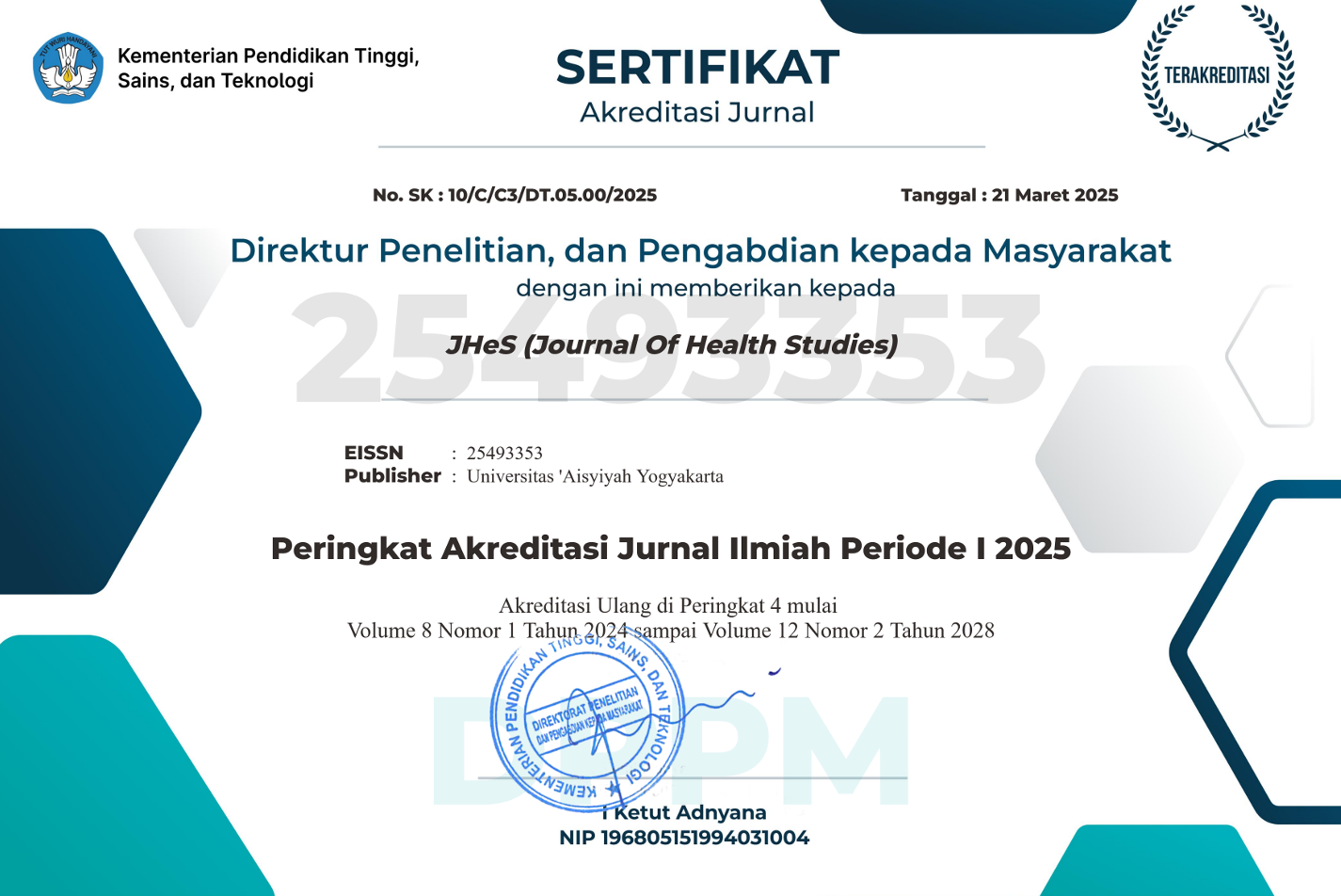Health education video project dalam proses discharge planning meningkatkan kesiapan keluarga merawat pasien stroke
DOI:
https://doi.org/10.31101/jhes.492Abstract views 2290 times
Keywords:
edukasi, video, discharge planning, kesiapanAbstract
Downloads
References
Afrida, Maryudella. (2017). Pengaruh Pemberian Self Care Education Program terhadap Tingkat Pengetahuan Perawatan Diri pada Pasien Haemodialisa di Rumah. Tesis. Yogyakarta: Universitas Muhammadiyah Yogyakarta.
Alligood, M. R. & Tomey, A. M. (Eds.). (2014). Nursing Theory: Utilization and Application 8rd edition. ST. Louis: Mosby Elsevier, Inc.
Clinical Advisory Board. (2010). Preventing Unnecessary Readmissions: Transcending The Hospital’s Four Walls to Achieve Collaborative Care Coordination. The Advisory Board Company.
Denny MC., Vahidy F., Vu KYT., Sharrief AZ., Savitz SI. (2017). Video-Based Educational Intervention Associated With Improved Stroke Literacy, Self-Efficacy, and Patient Satisfaction. PLoS ONE, 12(3), e0171952. https://doi.org/10.1371/ journal.pone.0171952.
Edelman, C.L. & Mandle, C.L. (2010). Health Promotion Througt Out The Lifepan. 7th edition. St.Louis Missouri: Elsenier Saunders.
Feigin VL., Forouzanfar MH., Krishnamurthi R., Mensah GA., Connor
M., Bennett DA., et al. (2014). Global and Regional Burden of Stroke During 1990–2010: Findings From The Global Burden of Disease Study 2010. The Lancet, 383(9913): 245–55.
Fens et al. (2015). A Process Evaluation of A Stroke-Specific Follow-Up Care Model for Stroke Patients and Caregivers: A Longitudinal Study. BMC Nursing, 14 (DOI 10.1186/s12912-014-0052-8).
Foster A., Brown L., Smith J., House A., Knapp P., Wright JJ., et al. (2012). Information Provision for Stroke Patients and Their Caregivers. Cochrane Database Syst Rev. Disitasi Juni 2017 dari http://dx.doi.org/10.1002/14651858.CD001919.pub3.
Hariyati RTS., Afifah E., Handiyani H. (2008). Evaluasi Model Perencanaan Pulang yang Berbasis Teknologi Informasi. Makara Kesehatan, 12:53-8.
Herminawati, Anisa. (2013). Perbedaan Lama Rawat Inap Antara Stroke Hemoragik dan Stroke Non Hemoragik di RSUD Tugurejo Semarang, (http://pmb.stikestelogorejo.ac.id/ejournal/index.php/ilmukeperawatan/article/view/108).
Jack BW., Chetty VK., Anthony D, et al. (2009). A Reengineered Hospital Discharge Program to Decrease Rehospitalization: A Randomized Trial. Ann Intern Med, 150(3):178-187.
Kementrian kesehatan RI. (2014). Pusat Data dan Informasi Kesehatan Republik Indonesia.
Kong K-H, Chua KS, Lee J. (2011). Recovery of Upper Limb Dexterity in Patients More Than 1 Year After Stroke: Frequency, Clinical Correlates and Predictors. Neuro Rehabilitation, 28(doi: 10.3233/NRE-2011-0639 PMID: 21447911): 105–11.
Mozaffarian D., Benjamin EJ., Go AS., Arnett DK., Blaha MJ., Cushman M, et al. (2016). Heart Disease and Stroke Statistics-2016 Update: A Report from The American Heart Association. Circulation, 133(4). https://doi.org/10.1161/CIR.0000000000000350PMID: 26673558.
Jones, Stephanie P., Jenkinson, Amanda J., Leathley, Michael J., Watkins, Caroline L. (2010). Stroke Knowledge and Awareness: An Integrative Review of The Evidence. Age and Ageing, 39(1): 11–22. https://doi.org/10.1093/ageing/afp196.
Rakhmilla, L. E., Larasati, R., & Sahiratmadja, E. K. (2017). Assessing Knowledge About Thalassemia Among Reproductive Age Population After Video Media Education. Journal of Biomedical and Clinical Science, 2(2): 30–32.
Riauwi, Mubaroq Hudrizal., Hasneli N, Yesi., & Lestari, Widia. (2014). Efektivitas Pendidikan Kesehatan dengan Penerapan The Health Belief Model terhadap Pengetahuan Keluarga tentang Diare. JOM PSIK, 1(2): 1-9.
Sahmad. (2015). Potensi Peran Keluarga Dalam Perawatan Penyakit Stroke Melalui Pengembangan Model Discharge Planning Berbasis Teknologi Informasi. Media Kesehatan Masyarakat Indonesia, 11(3): 154-159.
Scherbakov, N., Doehner, W. (2011). Sarcopenia in Stroke Facts and Numbers on Muscleloss Accounting for Disability After Stroke. Journal of Cachexia, Sarcopenia and muscle. 2(Doi : 10.1007/513539-011-0024-8): 5-8.
Tuong, W., Elizabeth R, Larsen., April W, Armstrong. (2012). Videos to Influence: A Systematic Review of Effectiveness of Video-Based Education in Modifying Health Behaviors. Journal of Behavioral Medicine, 37(DOI: 10.1007/s10865-012-9480-7): 218-233.
Downloads
Published
Issue
Section
License
With the receipt of the article by the Journal of Health Studies Editorial Board and the decision to be published, then the copyright regarding the article will be diverted to Journal of Health Studies. Universitas 'Aisyiyah Yogyakarta as the publisher of Journal of Health Studies hold the copyright regarding all the published articles in this journal.
Journal of Health Studies is licensed under a Creative Commons Attribution-ShareAlike 4.0 International License.













